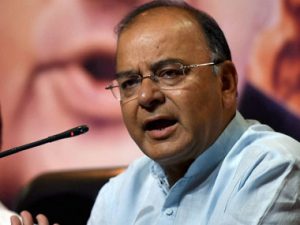 “The time to repair the roof is when the sun is shining,” said John F Kennedy at the State of Union Address on 11 January, 1962. Union Finance Minister of India, Arun Jaitley, appears to be following in letter and spirit what the US president had suggested 44 years ago. He has learned that politics is more important than economics the hard way. He also knows that his party, in spite of its unbeatable numbers in the Lower House of the Parliament, just cannot push through the all important Goods and Services Bill, which is described as the biggest tax reform measure in the country, unless he can muster the support of more and more regional parties in the Upper House. For want of numbers, he has been facing a road-bloc all these months. Things were at a standstill.
“The time to repair the roof is when the sun is shining,” said John F Kennedy at the State of Union Address on 11 January, 1962. Union Finance Minister of India, Arun Jaitley, appears to be following in letter and spirit what the US president had suggested 44 years ago. He has learned that politics is more important than economics the hard way. He also knows that his party, in spite of its unbeatable numbers in the Lower House of the Parliament, just cannot push through the all important Goods and Services Bill, which is described as the biggest tax reform measure in the country, unless he can muster the support of more and more regional parties in the Upper House. For want of numbers, he has been facing a road-bloc all these months. Things were at a standstill.
But now he knows the sun is shining brightly. And the roof can be repaired, with Prime Minister Narendra Modi doggedly pursuing what is being described as “politics of inclusion – and not exclusion” for a change. This apart, the ruling party has won additional Rajya Sabha seats in Jharkhand and Haryana. It has registered a spectacular victory in Assam with the help of Asom Gan Parishad and Bodoland People’s Front. It has also made huge gains in faraway Kerala, vote-share wise. And bolstered by favourable GDP and FDI figures, it continues to be in the celebratory mode. In short, Jaitley and all his friends in the NDA can sniff a “feel-good factor” all around.
Little wonder then that the finance minister did not lose time in making more and more regional parties from the opposition ranks agree to the idea of GST in principle at the meeting of finance ministers from 22 states in Kolkata on Tuesday. And if you can believe the finance minister, “all states except Tamil Nadu have agreed on the broader contours of GST.” But regardless of Tamil Nadu’s resistance, AIADMK supremo met Prime Minister Modi in New Delhi on Tuesday in a meaningfully congenial atmosphere. They appeared to be at their smiling best.
There is, at the same time, a third angle to the logjam in the parliament: The BJP’s dream of having a Congress-mukt Bharat cannot be achieved unless there is a Congress-mukt Rajya Sabha at the de facto level. And to be fair to the BJP, it must be said that the saffron outfit has been much more flexible in reaching “understandings, adjustments and alliances” with even antithetical parties compared to the Congress. Yes, it is historical truth.
How many of us remember that the Jan Sangh, which had merged its identity into the Janata Party, had in fact joined hands with Socialists and Marxists in 1977? And how many of us recall that the saffron outfit had rushed to join forces with even Mulayam Singh Yadav in the 1989 elections? Indeed, the BJP had shed its tag of “untouchables” long ago.
And if you have an eye for details, you would find that the current size of the BJP-led NDA is humongous: There are as many as 45 members from different states in this alliance. And 14 of these member-parties are represented in the Lok Sabha where the NDA accounts for 336 seats in all. In comparison, the Congress-led UPA occupies no more than 49 seats in the Lower House.
However, the scene is quite different in the Rajya Sabha where the UPA accounts 70 members as against NDA’s 67. It is the “others” who hold an ace up their sleeve with 108 seats. Herein lies the catch. The fate of the GST largely depends on leanings of this “camp of others”.
You can now understand why Arun Jaitley is burning midnight oil to ensure a positive response from the regional parties. He is doing his best. But the gap between the proverbial cup and the lips remains. And, on its part, the Congress is not sitting idle either. Sonia Gandhi and her aides are trying to build bridges with Mamata Didi and some others afresh.
Let’s keep our fingers crossed till the House of Elders meets next time.
 Supreme Court had accepted the Department’s plea to reject the declared transaction value of cars sold at a substantially lower price than the cost of manufacture. In short it has directed to invoke the provisions of the
Supreme Court had accepted the Department’s plea to reject the declared transaction value of cars sold at a substantially lower price than the cost of manufacture. In short it has directed to invoke the provisions of the
Central Excise Valuation (Determination of Price of Excisable Goods) Rules, 2000 to assess Central Excise duty. The logic behind the judicial decision is that there is additional consideration, as postulated in rule 6, that is lowing from the buyer to the assessee. Hence, money value of such additional consideration could be added to the declared transaction value and so Department’s claims have been agreed upon. In the above factual background, it was held by the Supreme Court that the tax authorities can reject the sale price and levy excise duty at manufacturing cost and profit. FIAT had admitted before the apex court that the purpose of such pattern of sale was to achieve market penetration. While the Supreme Court’s verdict is based on the specific facts of the case, the Revenue authorities in India tried to apply the principles laid down by the Supreme Court in the said decision at a generic level in all cases where the goods were sold at a loss. The recent amendment does not contemplate a circumstance where any money is flowing back to the assessee. If at all is there any, the situation shall suo moto be governed by the main clause of rule 6 which reads thus: “Where the excisable goods are sold in the circumstances
specified in clause (a) of sub section (1) of section 4 of the Act except the circumstance where the price is not the sole consideration for sale, the value of such goods shall be deemed to be the aggregate of such transaction value and the amount of money value of any additional consideration flowing directly or indirectly from the buyer
to the assessee.” Here, the situation was where money value of the additional consideration flows back to the
assessee from the buyer. The new version as appended to rule 6 is applicable where money value of additional
consideration does not flow back. It reads thus: “Provided that where price is not the sole consideration for sale of such excisable goods and they are sold by the assessee at a price less than manufacturing cost and profit,
and no additional consideration is flowing directly or indirectly from the buyer to such assessee, the value of
such goods shall be deemed to be the transaction value.” In both the main clause of rule 6 ibid and the newly added
proviso clause the context is ‘sale where price is not the sole consideration’. Deviation starts when ‘there is’ and ‘there is no’ additional consideration flowing back in the main clause and the newly added proviso clause
respectively. In the former case, the additional consideration that is flowing back to the seller from the buyer forms part of transaction value. One has to stop here to ponder if the alternative of the main clause is also true. In other words, when we remove the term “the aggregate of such transfer and the amount of money value of any additional consideration flowing directly or indirectly from the buyer to the assesse” it becomes “where the price is not the sole consideration for sale, the value of such goods shall be transaction value” which is same as the newly added proviso clause and emphatically contradictory to the provisions of section 4(1)(a). Central Board of Excise and Customs (CBEC) issued circular number 979/03/2014-CX, dated January 15, 2014, clarifying the following:
i) Mere sale of goods below the manufacturing cost cannot be taken as the sole basis for rejecting the transaction value ii) The circular quotes the Supreme Court wherein it has cited certain illustrations wherein the sale price
lower than the cost of manufacture and profit would be accepted for assessing excise duty liability, like in the case of a company which intends to switch over its business or where the goods could not be sold within a reasonable time iii) Due care must be taken at the level of the Commissioner to determine whether the facts of the
case are similar to the Fiat India case iv) Aspects such as the percentage of loss at which sale has taken place, the period for which such loss making price has prevailed, reasons for sale at such loss making price, etc., may be looked into by the field formation at the time of applying the principles of the Fiat India judgment during the course of audit v) The extended period of limitation may not be invoked by the Revenue authorities prior to the date of judgment in case of Fiat India, that is, before August 29, 2012. Conclusion: The new amendment makes yet another incongruity. When the amendment decrees ‘if the price is not sole consideration’ it presupposes that there is additional consideration. So, by the word of the edict, there is additional consideration; however, price that is lower than manufacturing cost also shall be transaction value if such additional consideration is not flowing directly or indirectly from the buyer to such assesse. Hence, it contradicts with the main clause which warrants inclusion of money value of any additional consideration to the declared value so as to become transaction value while the amendment does not require the assessee to include any such additional consideration.
